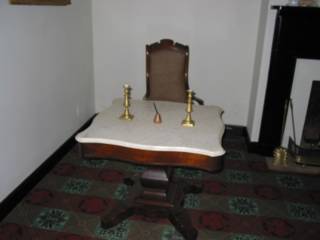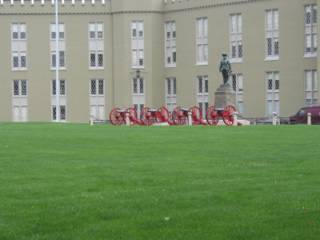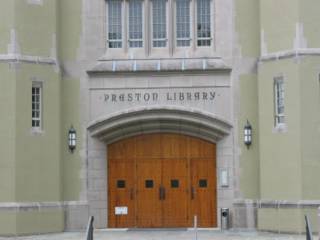As we headed out of Lexington, we cut through the mountains eastward, towards Appomattox. The scenery on this part of the trip was spectacular. There was the occasional mine site, and plenty of overlooks. It was not a long distance , as the crow flies; but it took us a couple of hours to get to Appomattox.
We arrived in Appomattox around 2:30, and Harry took us past the national park, to the location of General Lee's headquarters during the battle. It is not far from the McLean House, the site of the official surrender. Harry had Jim pull the bus off at a small historical marker, and we disembarked. The rolling hills of this part of Virginia are very serene, and I could sense what had come to pass here almost 145 years ago. Harry led us up a long, curvy trail through the woods, to the place where General Lee made his headquarters. I have a photo of the marker from this spot, posted below. Harry gave us a short lecture about how General Lee arrived at his decision to surrender to General Grant. One point that Harry made .... As the battle was nearing an inevitable end, and it was clear that there would be no scenario for victory, one of Lee's adjutants described to him a method of warfare that they could embark upon. That method was guerilla warfare. He proposed that Lee's remaining units could spread out, and re-form later, to commit warfare against the Union indefinitely. Lee did not consider this an option, and decided that it would be best if he were to surrender his men to General Grant. He knew that a never ending guerilla war would benefit no one. He chose the honorable path to peace. This was yet another example of how Lee's extraordinary character led him to his final decision. This decision spared the lives of many of his men, mostly malnurished; and it spared the rest of the nation from years of sporadic guerilla fighting across the land.
Finally, on the morning of April 9th, Lee sent word to General Grant. It was Palm Sunday. Lee dressed himself in his best uniform, and packed a gift for General Grant. He chose a very decorative ceremonial sword as this gift, because it was one that he did not like; He thought it was too gaudy. He climbed aboard Traveller, and rode down the path to Appomattox. General Grant met Lee in the front parlor of Wilmer McLean's home to discuss peace terms. The McLeans fled their home in Manassas at the start of the war to get away from it. Ironically, the war ended in the home that they fled to.
General Lee requested only that his men would recieve food and rations, and that they could keep their sidearms for protection on their journey home. Grant generously conceded. For a detailed account of the surrender, click here.
Click here for a site that has some articles that were written by Joshua Chamberlain after the surrender. He had great respect for Lee, as did Lee for him. There are also some other informative links on that site about Appomattox. Be sure to click the main title of this post, as it is a link to an informative Appomattox website. It has many pages of information.
















